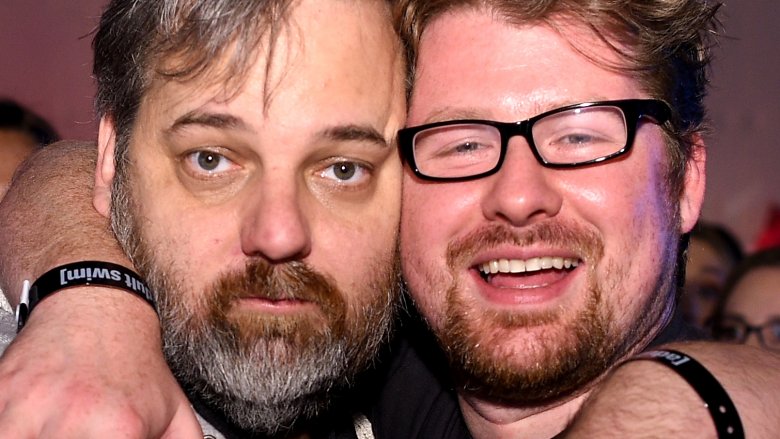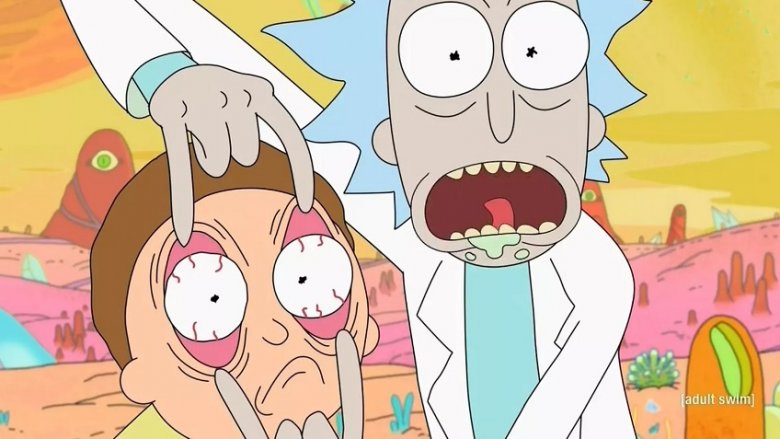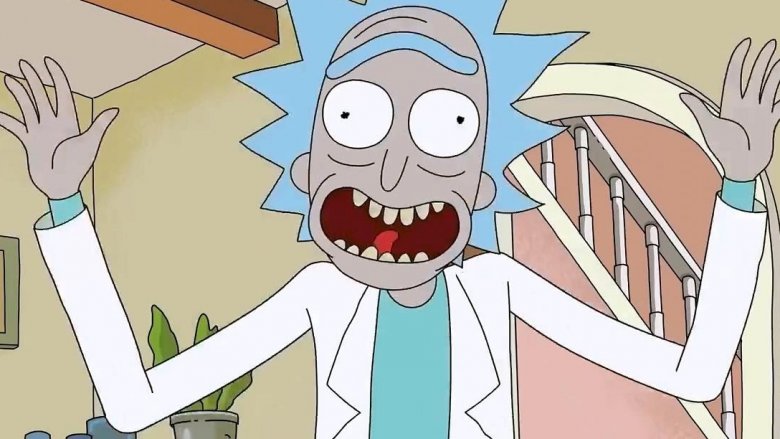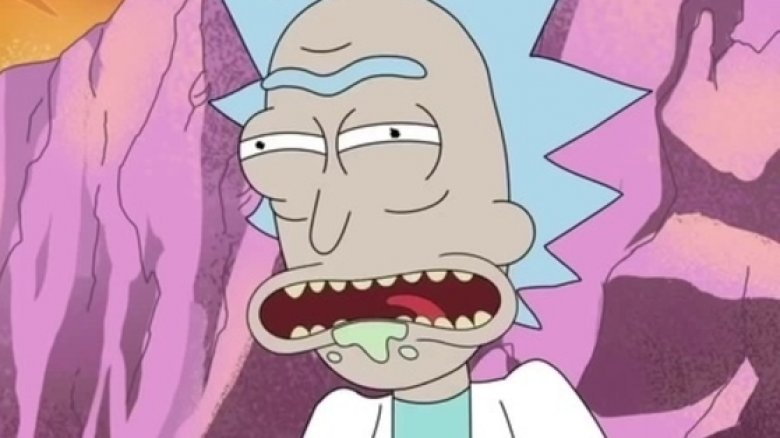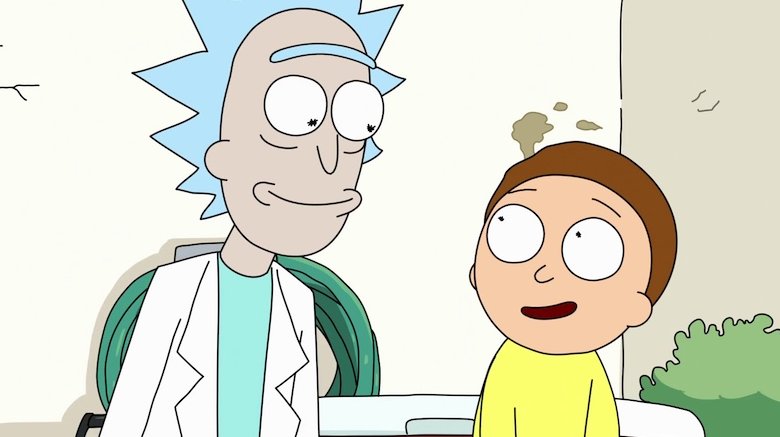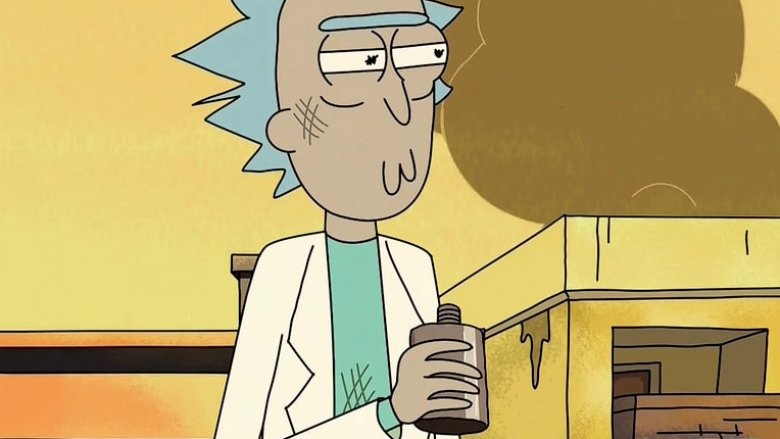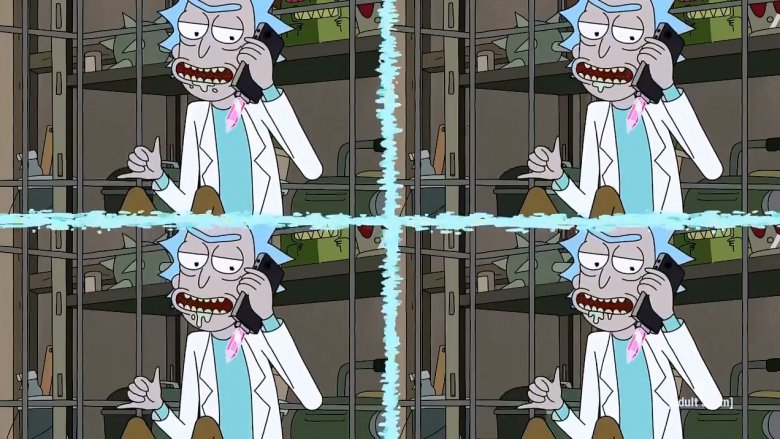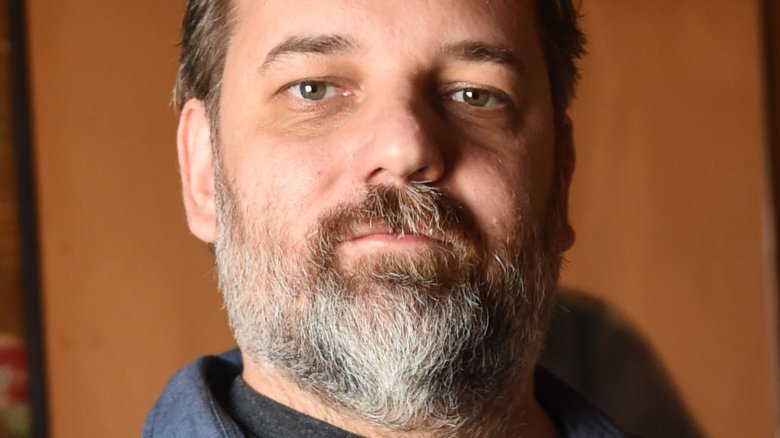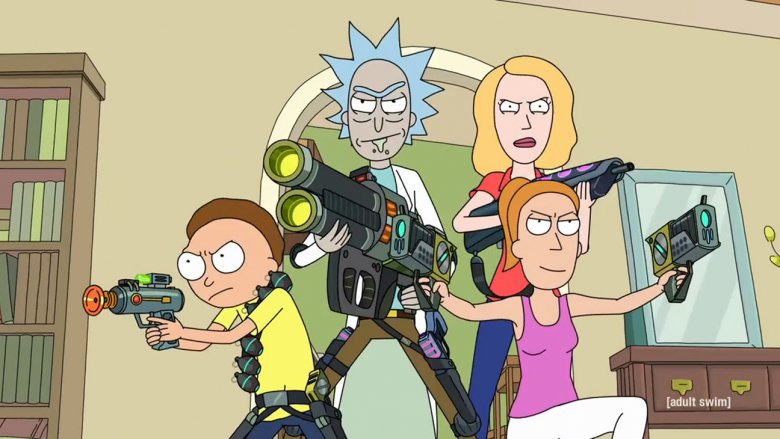Facts About Rick And Morty You May Not Know
If you're a Rick and Morty fan, you've probably already committed to memory an assortment of behind-the-scenes trivia. Co-creator and voice actor Justin Roiland drinks water and beer to burp while recording Rick's lines, for example. Or the fact that Rick and Morty were inspired by Doc and Marty McFly from Back to the Future, there's a pink and blue alien creature that appears in every inter-dimensional episode throughout the series, and you should never, ever trust Jerry with a Mr. Meeseeks box. But in the shadows remains a wide array of untapped information and hidden secrets, and we're here to bring it all to light with the facts about Rick and Morty you may not know.
Dan Harmon and Justin Roiland teamed up because of Bill Cosby
Where would the animated television world be without Rick and Morty co-creators Dan Harmon and Justin Roiland? It would be a lot less "schwifty," that's for sure, and fans have Bill Cosby to thank for bringing the pair together. Sort of.
In 2005, Roiland created House of Cosbys, an animated series focusing on a Bill Cosby superfan who builds a cloning machine to replicate the now-ostracized comedian. Roiland eventually submitted House of Cosbys to Harmon's Channel 101 film showcase, and the rest was history.
"I would go through phases in my involvement with Channel 101 where I would make stuff that was kind of intended to just shock people. [There was] a lot of screaming and people covering their eyes, groaning," Roiland said of his early endeavors that even involved a scathing cease and desist letter. While many found House of Cosbys disturbing, Harmon seems to have regarded it as worthwhile, and knew he wanted to work with Roiland in the future.
Harmon told the Los Angeles Times that when Adult Swim approached him about creating a series for the network, he thought working with Roiland, as he was positive the collaboration would be perfect. "I knew I wanted to work with Justin if I was going to work at Adult Swim," said Harmon. "I thought about Justin because he is the Adult Swim brand. He is the target for a lot of their stuff. And he's also, like me, really passionate about story and franchise."
The pilot was written in just a few hours
Rome wasn't built in a day, but Rick and Morty was. Well, the pilot episode's script was, at least. Immediately after Harmon and Roiland sold their pitch to Nick Weidenfeld, the head of program development at Adult Swim, the duo got started on writing—a move that was spurred by Harmon's concurrent involvement as showrunner on the NBC comedy Community. With the knowledge that schedules would be tight, Harmon and Roiland knew that time was of the essence, and so they wrote the pilot in just six hours.
Speaking with the Los Angeles Times, Harmon reflected on that whip-quick first writing session. "We literally had just sold the idea to Nick Weidenfeld and he was walking out of my unfurnished, empty Community office where I pitched it to him. [Roiland and I] were sitting on the floor, cross-legged with laptops and I was about to get up and go home and he said, 'Wait, if you go home, it might take us three months to write this thing. Stay here right now and we can write it in six hours.' He just had a premonition about that." Roiland described the process as "kind of lightning in a bottle," feeling that he and Harmon needed to get the story out right then and there. Suffice to say, countless Rick and Morty fans are glad that they did.
Rick's catchphrase was a complete accident
What started out as an off-the-cuff remark has turned into an ironic yet iconic catchphrase. Rick first used "wubba lubba dub dub" to punctuate a gag, as he mistakenly believed it originated from stand-up comedian and talk-show host Arsenio Hall. It's later revealed that the phrase translates from English to the language of the Bird People as, "I am in great pain, please help me." But contradictory to its troubling true meaning, and much like its rise to prominence, Rick's "wubba lubba dub dub" was entirely accidental.
The line was a last-minute rewrite, intended to be a reference to a bit from the slapstick trio the Three Stooges. When Roiland, who voices Rick, hopped in the recording booth, he got confused and spit the line out wrong, completely disregarding what was written. Roiland explained the mix-up: "It was scripted as parenthetical Larry or Moe from the Three Stooges—'wub wub wub wub wub.' And Rick was gonna fall on the ground and do that circle thing they do. And in the recording, that was a last minute rewrite that I didn't read, and I just didn't know what the f— I was looking at, and I just did it wrong."
Rick's signature burps were an accident, too
Frequent belches are a Rick Sanchez trademark, but they were yet another unintentional trait. The legend of the burps began back in 2006, when Roiland was recording the voices for the short "The Real Animated Adventures of Doc and Mharti," which would ultimately serve as the basis of inspiration for Rick and Morty. Roiland explained to Entertainment Weekly that he was simply goofing off and having fun doing "really crappy" Doc Brown and Marty McFly impressions when a burp came out naturally in the middle of the line.
Though the moment was gross, it was also pretty hilarious, and Roiland wanted to roll with it; as he put it, "I was like, 'Well, let's see if I can do that again for a couple more lines.'" Fast forward a few years: when it was time for Roiland to lend his versatile pipes to Rick and Morty, he pitched voices for both title characters—with a healthy sprinkling of gassy sounds added to the hyper-intelligent scientist. "Right out of the gate," said Roiland, "the burping was part of [Rick]."
Rick and Morty's dynamic is a representation of mental illness
The timid grandson (who's growing increasingly aggressive as time goes on) and the super-genius grandpa pair aren't just rooted in the Back to the Future trilogy; they grasp onto a darker, more complex foundation as well. On the Rick and Morty season one commentary DVD, Harmon describes the pair as "an accurate personification of bipolar disorder," with Rick being the manic "side" of the brain and Morty, the depressive. This would make sense, given how Rick and Morty are able to maintain a generally functional relationship despite being vastly different. Even fans have backed this theory, arguing that Rick and Morty is "a sympathetic and interesting portrayal of bipolar disorder, an underrepresented and often misunderstood illness." By the sounds of it, Rick and Morty could very well be two halves of one whole, adding a mind-blowing notion to the series' already rich, labyrinthine universe.
The theme song is inspired by classic sci-fi shows
Rick and Morty is jam-packed with sci-fi references, from obscure '70s flicks that center around massive floating heads to well-known galaxy-faring shooter games like Space Invaders. To imbue the out-of-this-world vibes of the genre into every nook and cranny of the show, Harmon and Roiland turned to two beloved television series when crafting the theme song. Roiland revealed to TVOvermind that Doctor Who and Farscape were the biggest inspirations: "The theme song is written by [Ryan Elder] the guy who wrote the Wizards of Waverly Place theme song, who is a very good friend of mine. I told him I was a big fan of Farscape and that I wanted to combine Farscape's theme with Doctor Who's theme, and that's basically what our theme song is. It's this amazing original piece that takes the best aspects of those two themes and mashes them together." The end result is a trippy track that Roiland calls "super sci-fi."
Harmon has an idea of what's in Rick's flask
Fans have long debated what Rick's drink of choice is, including delectable-sounding galactic cocktails like "super seed juice" and "Pan Galactic Gargle Blaster," and even 200-proof alcohol. But Harmon has a wildly simple theory: "I tend to assume vodka," he revealed during a Reddit AMA session when asked what exactly sloshes around in Rick's trusty flask. And Harmon's fully aware that such an earthly drink seems out of character for Rick, as he could easily use sci-fi tech to augment anything he sips, but Harmon believes Rick's addiction to his flask—and to alcohol in general—"anchors his identity."
"I think he knows that if he augmented the booze or the flask, then why not just whip up a very rudimentary nanobiotic alcohol dispenser in his body or inject himself with a plasma component that just amounts to always having a certain blood alcohol level," Harmon stated, "and I think the reason he doesn't do that is because he's a little afraid he'll lose sight of who he is."
So we sort of know which drink Rick is tethered to, but will we ever know why he started drinking in the first place? Short answer: no. According to Harmon, Roiland has argued that revealing that part of Rick's backstory would be "very shark-jump-y," likening it to finding out that the Fonz from Happy Days "didn't always wear leather jackets."
Harmon and Roiland didn't like a fan favorite episode
Ask any Rick and Morty fan what their favorite episode is, and they'll likely tell you one of the two inter-dimensional cable installments or the season two premiere, "A Rickle in Time." The episode has popped up on numerous "best of" lists, held in high esteem for its co-existing timelines, overlapping possibilities, and nuanced commentary on morality. But there are two people who weren't so keen on it: Harmon and Roiland.
Before "A Rickle in Time" became a fan favorite, it was a daunting project for the co-creators, as it was the introductory episode after a 15-month hiatus between the first and second seasons. Roiland confessed to Rolling Stone that the whole process was "just brutal," and that it nearly defeated him and Harmon. "It broke us to a certain extent. We were so close to something amazing and we never really got there from a structural standpoint." Harmon agreed, admitting that he and Roiland genuinely thought it would be the worst episode of the second season. "It went off the deep end conceptually and got really over-complicated," he said. "We're pretty convinced that the first episode might be the worst for that reason."
Thankfully, all the pieces fell into place and viewers were gifted with a stellar episode that peeks into the weirdness of existence and proves that the Smith family is as gullible as ever.
The reference to Harmon's divorce
During production on the show's third season, Dan Harmon was going through a divorce from his now ex-wife Erin McGathy, a podcast host, artist, and comedian. The pair became engaged in December 2013, and married in what appeared to be a hilarious, unique, and love-filled wedding at Los Angeles' Natural History Museum the following November. Less than a year later, McGathy dropped a bombshell by confirming she and Harmon were formally separating. "Sad to announce that Dan Harmon and I are divorcing. We ask that you respect our privacy as we discuss it openly on our respective podcasts," McGathy wrote on Twitter in October of 2015, just a few months following the announcement that Rick and Morty had been picked up for a third season. While divorce in any circumstance is difficult, there's something devastating about Harmon's from McGathy in relation to Rick and Morty.
After the series' end credits, a Rolodex of silly splash screens appear, one of them being Harmon's own "vanity card" that reads "Harmonious Claptrap" in scribbly, child-like handwriting. In the first two seasons of Rick and Morty, the slate features claymation versions of Harmon and McGathy snuggled up on the couch, watching television, with a cat on their lap and a dog panting happily on the floor. Post-divorce, there's a new vanity card that shows Harmon sprawled out on the same couch alone, with a bottle of liquor in his hand and booze strewn about the floor. It's an image harrowing enough to break your heart.
Female writers were a big part of season three
For the first two seasons, the Rick and Morty writing staff was predominantly male: Roiland, Harmon, Tom Kauffman, Ryan Ridley, Wade Randolph, Eric Acosta made up the core, along with writing assistant Mike McMahan. Described as a "very, very tiny little writers' room with a lot of heavy lifting from everybody," and a team that often engaged in Lego competitions and Nerf gun battles, the series' group of scribes was in need of a shake-up.
Season three saw the first "gender-balanced" writers' room in the show's history, and both Harmon and Roiland credit female writers for playing a massive role in how the season panned out. Not only did they help ease self-doubt behind the scenes (of which there was reportedly a lot) and contribute to a renewed creative energy, the female writers also allowed room for everyone to pitch ideas for awesome Beth and Summer storylines.
"We had [a gender-balanced writers' room] for this season and I thought the results were really good because it meant that both the men and the women could increase their attention on Beth and Summer... nobody represents any gender because if nobody outnumbers anybody else, then nobody's an ambassador to anything," Harmon explained. "When you have a mixed room, it's not about the women going, 'Here's a bunch of secrets about women.' It's more about everyone being freer to just pitch randomness. So the result is you see cool stuff happen with Beth and Summer this season."
Thanks, ladies!
